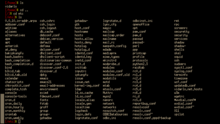 A sample xterm, running the Bash shell, showing a listing of /etc. | |
| Original author(s) | Mark Vandevoorde |
|---|---|
| Developer(s) | Thomas Dickey |
| Initial release | 1984 |
| Stable release | 395[1] |
| Repository | |
| Operating system | Unix, Unix-like, MVS OpenVMS, OS/2 |
| Type | Terminal emulator |
| License | MIT/X Consortium License |
| Website | invisible-island |
xterm is the standard terminal emulator for the X Window System. It allows users to run programs which require a command-line interface.
If no particular program is specified, xterm runs the user's shell. An X display can show one or more user's xterm windows output at the same time.[2][3] Each xterm window is a separate process, but all share the same keyboard, taking turns as each xterm process acquires focus. Normally focus switches between X applications as the user moves the pointer (e.g., a mouse cursor) about the screen, but xterm provides options to grab focus (the Secure Keyboard feature) as well as accept input events sent without using the keyboard (the Allow SendEvents feature). Those options have limitations, as discussed in the xterm manual.[4]
XTerm originated prior to the X Window System. It was originally written as a stand-alone terminal emulator for the VAXStation 100 (VS100) by Mark Vandevoorde, a student of Jim Gettys, in the summer of 1984, when work on X started. It rapidly became clear that it would be more useful as part of X than as a standalone program, so it was retargeted to X. As Gettys tells the story, "part of why xterm's internals are so horrifying is that it was originally intended that a single process be able to drive multiple VS100 displays."[5]
After many years as part of the X reference implementation, around 1996 the main line of development then shifted to XFree86 (which itself forked from X11R6.3), and it is now maintained by Thomas Dickey.
Many xterm variants are also available, such as hanterm, a variant tailored to Korean speakers, and kterm, which is designed for Japanese speakers.[6] Most terminal emulators for X started as variations on xterm.[discuss][7]
- ^ https://invisible-island.net/xterm/xterm.log.html#xterm_395.
{{cite web}}: Missing or empty|title=(help) - ^ Rothman, Ernest E; Jepson, Brian; Rosen, Rich (2008-09-18). Mac OS X for Unix Geeks (Leopard): Demistifying the Geekier Side of Mac OS X. "O'Reilly Media, Inc.". ISBN 978-0596555191.
- ^ Wagner, Bill (1998). The Complete Idiot's Guide to UNIX. Penguin. ISBN 978-0789718051.
- ^ "xterm(1)". Security. Retrieved December 21, 2021.
- ^ Thomas E. Dickey. "XTerm – Frequently Asked Questions (FAQ), Who wrote XTerm?". Archived from the original on 2018-06-24. Retrieved 2018-06-04.
- ^ Thomas E. Dickey. "XTerm – Frequently Asked Questions (FAQ), What versions are available?". Archived from the original on 2018-06-24. Retrieved 2018-06-04.
- ^ Ric Lister (27 October 1999). "How to change the title of an xterm". 6. Appendix: escapes for other terminal types.